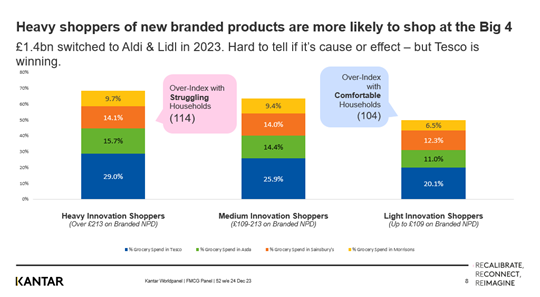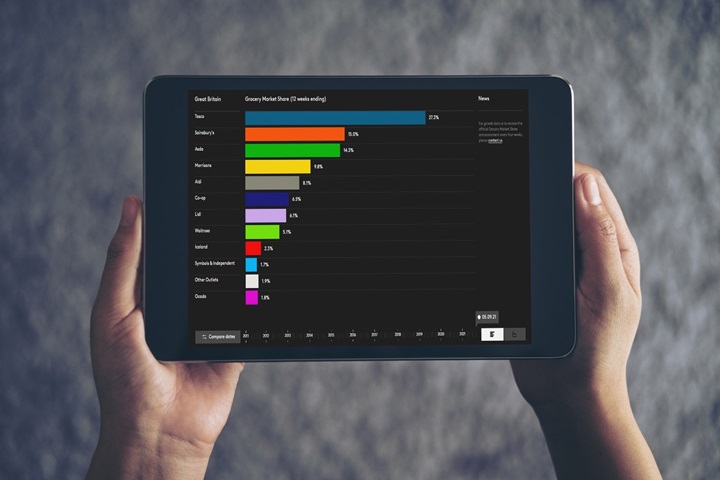Innovation in the UK's fast-moving consumer goods (FMCG) sector has proven both a necessity and a battleground in recent times. From legislative pressures around less healthy foods to shifts in consumer purchasing patterns, brands have been battered by headwinds.
But those who have used those winds of change to drive change for themselves appear to have won out on the innovation front. The market challenges have forced new ways to find relevance and recruit new shoppers.
So, what do the numbers tell us? For the top 10 branded manufacturers, over 11% of sales in 2023 came from branded NPDs and over 43% of their growth was driven by branded NPD sales. Such statistics not only highlight the importance of innovation but also its role as a lifeline in a market grappling to find real growth amidst ongoing inflationary pressures that have impacted consumer desires to expand their baskets.
In other words, growth can still be found.
Working Hard for the Money
But new products have also had to work harder than normal to bump other products off the shelves as retailers optimise their assortment in favour of private label options that help their pressured margins.
And yet, despite a seeming plateau in the rate of new market entrants in recent years, innovation has not halted; it has shifted, with significant activity still seen in sectors like beverages and pet food, where short-term gains have often been the innovation target. Not all winning innovations have particularly long-life spans, but they tend to drive meaningful growth even if it’s in the short term. Failing to introduce new products risks going backwards, as innovation is pivotal for maintaining brand presence and securing retail space.
Regulatory changes have also had a knock-on effect on the innovation landscape. The introduction of HFSS (high in fat, salt, sugar) legislation in late 2022 meant categories typically focused on introducing new products, such as snacks and confectionary, had instead moved to reformulate existing products to comply with new standards.
Money Magnet
But innovation has pressed on elsewhere, and it hasn’t just been about brands boosting their basket presence. The availability of innovative products can significantly influence shopping behaviours, drawing consumers to stores more frequently. This trend is particularly strong in major retail chains, such as Tesco, where innovative offerings help to maintain customer interest and engagement.
Indeed, innovations tend to attract heavy spenders—those who invest over £213 annually on new products — to larger stores, creating a symbiotic relationship that boosts both consumer satisfaction and retailer performance. This dynamic underscores the complexity of innovation's role in retail growth, which, though nuanced by economic conditions, remains a robust element of strategic retail management.

The impact extends to discount retailers like Lidl, though somewhat differently, as they push hard on innovation within their private label selections, suggesting that innovation is vital across all retail formats.
New products such as Boots No. 7's Future Renew skincare products, which topped our latest innovation rankings, also demonstrate that effective innovation can command premium pricing and drive category growth, particularly in sectors like health and beauty, where brand loyalty and product efficacy are crucial.
Radiant Results

Yet, despite innovation's strategic importance, understanding of its growth prospects remains nuanced. The inflationary backdrop distorts straightforward analysis, but innovation is holding its own for those paying attention and using it well.
One who used it well was newcomer PerfectTed, a matcha tea energy drink and Dragon’s Den television show winner. PerfectTed delivered the most incremental product by value to both the category and the brand. However, its growth wasn’t in the obvious places. It found incrementality by adding 42% of trips from existing energy drink shoppers, more than the percentage increase from trade-ups or new market penetration.
What Next?
Looking ahead, the path of the FMCG sector will likely be influenced by both broader economic factors and specific consumer behaviours. The phenomenon known as the "lipstick effect" may support growth in certain categories, reflecting a consumer propensity to indulge in affordable luxuries during tougher economic times. Effective innovation will, therefore, require a careful balance between creative impulse and pragmatic market analysis.
Achieving scale, longevity, and incrementality simultaneously is a Herculean task, often leading to disillusionment about the innovation process itself. Brands working on innovation need to be very clear about what they are trying to achieve upfront and focus on it relentlessly.


